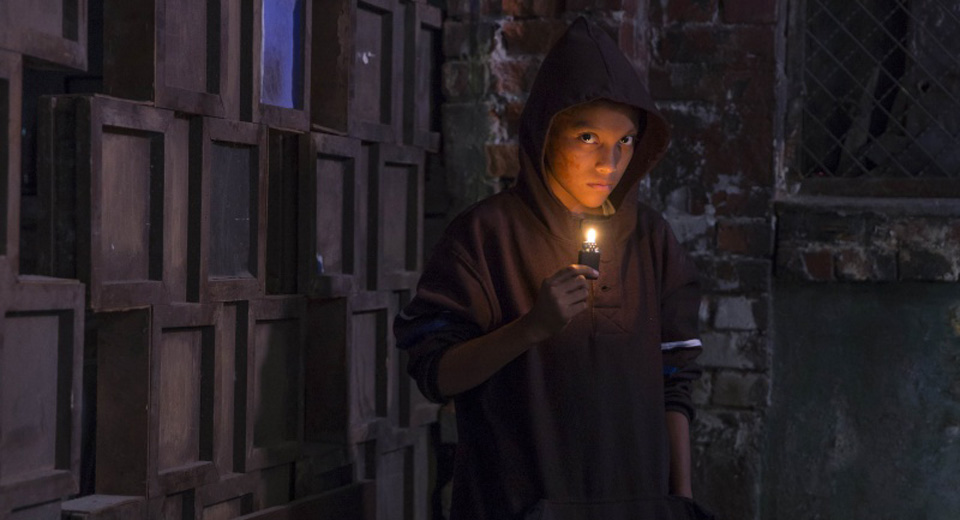
Screamfest Los Angeles, a long-running film festival highlighting movies in the horror genre from up-and-coming filmmakers and established film icons, kicked off on October 10. In the midst of slasher flicks, killer clowns, and all other things that go bump in the night, there were a number of films that used the theme of horror to bring attention to the real-world “monsters” of our current reality.
One such film is Tigers Are Not Afraid, which uses a morbid fantasy world to display the reality of the raging epidemic of violent drug wars and human trafficking in Mexico that is leaving cities in ruin and children without mothers. It is a beautiful movie that will haunt you into wanting to do more after the credits roll.
Set in an unnamed Mexican city that has been turned into a ghost town by the drug wars, the main character, Estrella, age 11, comes home from a school shooting to find that her mother has vanished. Estrella makes a wish for her mother to return. The young girl’s wish is fulfilled, but in the most horrifying way, as her mother returns from the dead, now a spirit with a dark message.
Estrella, who is afraid for her life, escapes her home and joins up with a little gang of young boys also orphaned by violence. From there, Estrella and the young men’s journey takes shape as they try to survive the streets and avenge their lost parents by going after the organized criminals and corrupt politicians that plague the city. The film is reminiscent of “Peter Pan and the lost boys” but with a twist, as a young woman protagonist takes center stage.
The use of the tiger, and the fictional story of the Tiger Prince, throughout the movie serves as symbolism for the resilience of those affected by the violence plaguing the city. This recurring theme works well, as the story of the mythical tiger spirit intertwines with the fight of the children to survive. As the official trailer for the film explains in Estrella’s voice, “Once upon a time there was a Tiger Prince. We are princes, warriors…tigers. Tigers are not afraid.” This message resonates as Estrella’s journey unfolds.
The subtle beauty in the film is the merging of the real world with fantasy, as inanimate objects come to life and childhood imagination takes hold in the sea of a dismal reality. The young actors are the stars of this film, as they display a range of emotions based on their conditions, from confusion and rage to despair and, at times, hope.
This isn’t just a horror film with an endless quantity of dead bodies. The story forces the viewer, through the children, to not be desensitized by the violence, but to understand its impact on the people. The young stars, such as Paola Lara and Juan Ramon Lopez, humanize the story. Although there are ghosts and ghouls in the film, the real evil isn’t necessarily the thing of fairy-tales, but the reality of a town left in despair by corruption and greed.

The film’s director and writer, Issa Lopez (600 Miles, Casi Divas), met with the audience following the film’s Screamfest premiere, speaking to the messaging behind her creation. Lopez explained how she wrote the script at a time when she was trying to get another film made, yet it became the most personal script of her career thus far. “[This film] that has magic mixed with reality is the most real story I’ve ever written,” Lopez proclaimed.
Referencing the real danger for women and children in Mexico, Lopez explained further: “[What’s happening in] Mexico needs to be an everyday conversation. It’s the problem of the children. A lot of women disappear. Many happen to be single mothers, workers, and immigrants who go to Mexico to find work. We speak of the Syrian refugee crisis often, as we should, but there is a ‘Syria’ happening right next to us in Mexico every day. Areas in Mexico are becoming ghost towns.” [The largest source of undocumented immigrants in Mexico is the impoverished Central American countries of Guatemala, Honduras, and El Salvador bordering Mexico to the southeast. Editor]
Lopez is speaking to the very real issue of female homicides and kidnappings happening in Mexico. These kidnappings, assaults, and murders have been attributed to robbery, gang wars, human trafficking, and sexual assault. Nearly 1,238 women were reported missing in 2011 and 2012 alone. According to the International Organization for Migration, an estimated 20,000 people are trafficked in Mexico. The majority are forced into prostitution. In 2015, for the first time, an “Alert of Gender Violence Against Women” was declared.
Despite this declaration, human rights activist and women have had to continue to point out the the government’s inability and unwillingness to reduce the high rate of murders and gender based violence in the state. Lopez’s film uses fantasy to highlight the all too real nightmare that is happening to the women of Mexico.
Tigers Are Not Afraid is a dark tale of lost childhood innocence with a backdrop of real-world issues. With an apt running time of one hour and 23 minutes, the viewer is transported to a land not really far from home at all. For those of us in the United States, it is happening right in our backyard. It’s a movie worth watching, and a story worth telling.
Currently, Tigers Are Not Afraid is being shown on the festival circuit with a goal to be distributed worldwide in the near future. The official trailer can be seen below.










